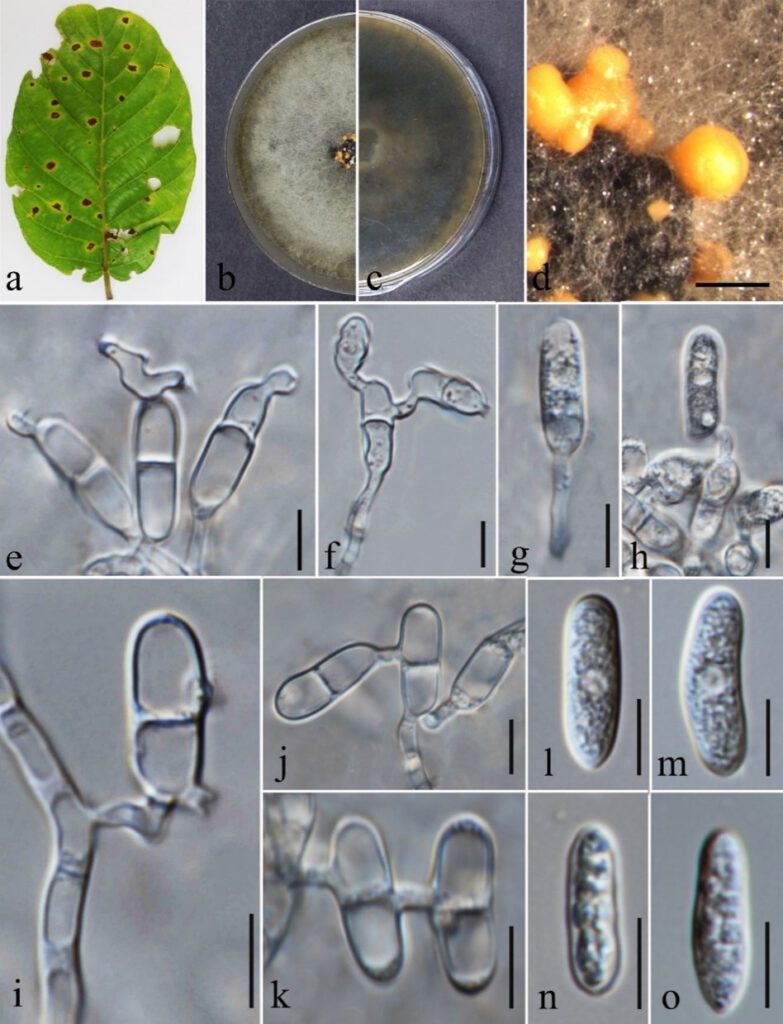Colletotrichum aeschynomenes B.S. Weir & P.R. Johnst., in Weir, Johnston & Damm, Stud. Mycol. 73: 135 (2012)
MycoBank number: MB 563590; Index Fungorum number: IF 563590; Facesofungi number: FoF 11441;
Associated with leaf spots of Shorea siamensis. Sexual morph Not observed. Asexual morph Vegetative hyphae 1.5–4.5 µm diam. (x̄ = 3.4, n = 15), hyaline to pale brown, smooth-walled, septate, branched. Pycnidia forming on MEA, 500–1000 μm diam. solitary or aggregated, globose to irregular, releasing conidia in milk-orange, slimy, glistening masses. Setae not observed. Conidiophores 8.0–53.0 × 1.5–4.5 μm (x̄ = 25.1 × 2.8 μm, n = 20), hyaline to light brown, cylindrical to clavate, smooth-walled, septate, sometimes branched or reduced to conidiogenous cells. Conidiogenous cells 1.5–16 × 1.5–4 μm (x̄ = 6.1 × 3.0 μm, n = 15), hyaline to pale brown, solitary or aggregated, cylindrical, ovoid or ampulliform, smooth-walled. Conidia 17.0–24.5 × 5–7.5 μm (x̄ = 20.2 × 6.0 μm, n = 60), aseptate, hyaline, cylindrical, clavate or ellipsoidal, with slightly curved basal end and mostly rounded apices, smooth-walled or slightly verruculose, guttulate, forming conidial anastomosis tubes. Conidial anastomosis tubes 2–10.5 × 2–3 μm (x̄ = 4.6 × 2.4 μm, n = 15), hyaline to brown, smooth-walled, aseptate. Appressoria not observed.
Culture characteristics: Colonies on MEA flat or effuse with entire margin. Greyish white, reverse olivatious, grey towards the edge, reaching approximately 70 mm diam. in 5 days at 25 °C, with 20-days for sporulation. Aerial mycelium dense.
Material examined: Thailand, Chiang Mai Province, Omkoi, on leaf spots of Shorea siamensis (Dipterocarpaceae), 15 October 2019, D. Gomdola, **** (MFLU XXX) living culture MFLUCC XXX.
Known host and distribution: Aeschynomene virginica (USA), Manihot esculenta (Thailand), Myrciaria dubia (Brazil), Platostoma palustre (Taiwan: China), Shorea siamensis (Thailand, this study), Theobroma cacao (Brazil) (Farr and Rossman 2022).
GenBank numbers: ITS = OP278978, GAPDH = XXX
Notes: Weir et al. (2012) introduced C. aeschynomenes from a stem lesion of Aeschynomene virginica. Colletotrichum aeschynomenes is a common phytopathogen known to cause anthracnose in leaves. Listed chronologically, the pathogen has been found to infect cassava in central Thailand (Sangpueak et al. 2017), and cause anthracnose on Theobroma cacao in Brazil (Nascimento et al. 2019), Myrciaria dubia in Brazil (Matos et al. 2020) and Ixora coccinea in China (Li et al. 2021). Herein, C. aeschynomenes is associated with leaf spots of Shorea siamensis. To delineate C. aeschynomenes from C. fructicola, Tub2 or GAPDH gene regions are required (Weir et al. 2012). Phylogenetic analyses based on the concatenated ITS and GAPDH sequence data depict our isolate as C. aeschynomenes. The latter is located in the C. gloeosporioides complex and clusters with the ex-type strain (ICMP 17673). We report our collection as a new host of C. aeschynomenes on living leaves of Shorea siamensis

Fig. **** Colletotrichum aeschynomenes (MFLU XXX) a Leaf of Shorea siamensis with leaf spots, which the fungus was isolated from b Front colony on MEA c Reverse colony on MEA d Orange coloured spore masses on MEA e–j Conidiogenesis k Conidia fused by conidial anastomosis tubes l–o Conidia. Scale bar. d = 1000 μm, e–o = 10 μm
